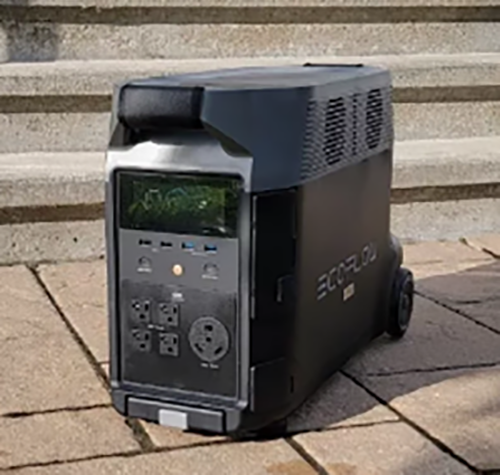In recent years, while the popularity of mobile smart terminal applications such as mobile phones and tablet computers has continued to increase, it has become a trend to seek freedom and outdoor life close to nature, and the demand for outdoor electricity is increasing; in addition, natural disasters have frequently occurred in recent years, power supply Stability is affected, and emergency backup power has gradually become an important backup in family life. In the past, small fuel generators were mainly used for outdoor and emergency power supply. However, fuel generators are noisy, complicated to operate and pollute the environment. Therefore, the portable energy storage industry based on clean energy technologies such as lithium batteries is gradually emerging. At the same time, driven by the development of new energy vehicles, the upstream lithium-ion battery industry has matured, and the portable energy storage industry has developed rapidly.

Portable energy storage is a small energy storage device with a built-in lithium-ion battery. It can provide a power system with stable AC/DC voltage output. It has the characteristics of large capacity, high power, safety and portability. It is suitable for: 1) outdoor activities, for mobile Power supply for computers, etc., to meet the diverse and convenient needs of outdoor travel; 2) Emergency relief, in earthquake and tsunami-prone areas, can form a small power generation system with solar panels to meet the electricity needs of victims. Portable energy storage products are currently roughly divided into two categories according to the charging capacity: 1) The charging capacity is 0.5-1kWh. The product structure and system are relatively simple. 2) Portable energy storage devices with a charging capacity of more than 1.5kWh mainly make up for the blank market between diesel generators and charging treasures. At the same time, the difficulty of system integration is also increasing for energy storage devices with greater charge capacity. Products with a charged capacity of more than 2kWh require certain technical thresholds in terms of PCS, batteries, power modules, etc., and have higher requirements for safety. With the increase of users’ electrical equipment, the power requirements for portable energy storage equipment are also gradually increasing.
Portable energy storage products are consumer electronics products. At present, almost all portable energy storage brand companies use a combination of online and offline models to achieve global sales, and online sales are their most important sales channels. From 2016 to 2018, online sales accounted for less than 50%. Since the “COVID-19” epidemic in 2020, the global online consumption habits have accelerated, and the increasing popularity of consumption habits will help the global development of the portable energy storage industry. In 2021, the proportion of online sales of global portable energy storage has exceeded 80%. The supply chain is concentrated in China. Portable energy storage products are manufactured products, which are more sensitive to the cost of upstream components and labor costs. China’s supply is relatively sufficient, and it has certain advantages in the supply of raw materials and parts. At the same time, China’s consumer electronics manufacturing industry has complete upstream and downstream facilities, and its comprehensive advantages are obvious. Therefore, the world’s portable factories are mainly distributed in China, accounting for more than 90% of production and shipments.

The proportion of renewable energy power generation has increased, and the role of natural gas in balancing the electricity market has increased. From the perspective of European energy power generation structure, the proportion of renewable energy power generation is gradually increasing, the proportion of nuclear power is gradually decreasing, and the proportion of natural gas is stable. Due to the instability of renewable energy power generation, natural gas power generation has gradually become an important link in Europe’s balanced electricity market. In 2021, natural gas power generation in Europe will account for 26%, renewable energy such as hydropower, solar energy, and wind power will account for 35%, nuclear power will account for 22%, and coal will account for 15%. The current electricity price mechanism in Europe adopts the Merit-Order (priority order) principle. Merit-order refers to the order in which power plants provide electricity. The core of pricing is based on the lowest marginal cost of energy, so the electricity price in this mechanism is determined by the most expensive source required to meet a given level of demand. At present, among all kinds of power generation sources in Europe, the price of natural gas continues to rise, which is the most expensive source, driving the continuous increase of electricity prices in Europe.

Take Japan, which has a high incidence of disasters, as an example. The earthquake in eastern Hokkaido in September 2018 caused a power outage in the entire Hokkaido, and the direct economic loss caused by the power outage exceeded 150 billion yen; the typhoon “Tami” in September 2018 caused more than 70,000 households in Okinawa Prefecture Households without power. Portable energy storage products can solve power shortage problems such as disaster power shortage, power outage, emergency rescue, etc., and can be combined with solar panels to form a small solar power generation system. In 2019, the Japan Disaster Prevention Association has listed portable energy storage products as disaster prevention and safety materials certification products. In the future, with the gradual popularization of emergency backup power and the gradual replacement of small fuel-fired generators by portable energy storage products, the demand space for portable energy storage products in the emergency disaster preparedness market will be even wider. It is estimated that by 2026, the new demand in the global emergency field will reach 11.55 million units.
With the rapid development of the global new energy industry, lithium batteries, as the most widely used chemical secondary batteries, have been continuously improved in recent years. and the first choice for energy storage batteries. Driven by new energy vehicles and the energy storage industry, domestic power and energy storage battery companies have accelerated production capacity, and the expansion of scale advantages has further reduced the price of lithium-ion batteries. In addition, the mature technologies of lithium iron phosphate and sodium-ion batteries have further controlled Therefore, the price of portable energy storage products with lithium battery as the main component is expected to be further reduced, and its substitution advantage for traditional small fuel generators will be more obvious, and its penetration rate in the overall market will also increase rapidly.

Portable energy storage not only makes up for the gap between charging treasures and generators, because its life cycle cost is cheaper than that of fuel generators, and it is more convenient to operate, higher in efficiency and cleaner, it is also suitable for small fuel generators machine has a substitution advantage. With the gradual popularization of emergency backup power and the gradual replacement of small fuel generators by portable energy storage products, the demand space for portable energy storage products in the emergency and rescue and disaster relief market will be even wider. Optimistically, in the context of global new energy development trends, the cleanliness advantages of portable energy storage are inevitable for the replacement of small fuel-fired generators, but fuel-fired generators are cheap, mature in technology, and have large output power at the same time (Usually up to 2-8KW), it can output power for a long time by continuously adding fuel, while portable energy storage is only suitable for backup power and short-term applications, and the charge capacity is mostly about 1000Wh, which is not suitable for continuous power consumption or power demand larger users

Compared with traditional fuel generators, portable energy storage devices have certain advantages, but at the same time, they also have disadvantages, so they are only feasible in some application scenarios. From the perspective of output power, the maximum power of portable energy storage is generally 3KW, while the output power of traditional fuel generators can reach up to 2-8KW, so the replacement ratio may be low in high-power consumption scenarios; from the perspective of power supply, Portable energy storage capacity is generally in the range of 100-3000Wh, while traditional fuel generators can provide sustainable power, so the alternatives are poor in fields that require long-term electricity consumption. However, from the perspective of volume and weight, portable energy storage is lighter and more convenient to carry, so it is more likely to be replaced in fields such as light travel or emergency rescue in complex terrain; Pollution, no noise, and comfortable use; From the perspective of periodic costs, 1000Wh portable energy storage costs about 3,000 yuan, and does not require maintenance. The unit cost of a traditional fuel-fired generator is about 2,000 yuan, but the periodic maintenance cost is relatively high. Taking diesel as an example, the use cost is about 0.7 yuan/kWh; from the perspective of service life, about 80% of the portable energy storage is Initial power, while traditional fuel generators can last for 10,000 to 30,000 hours and have a longer service life.






